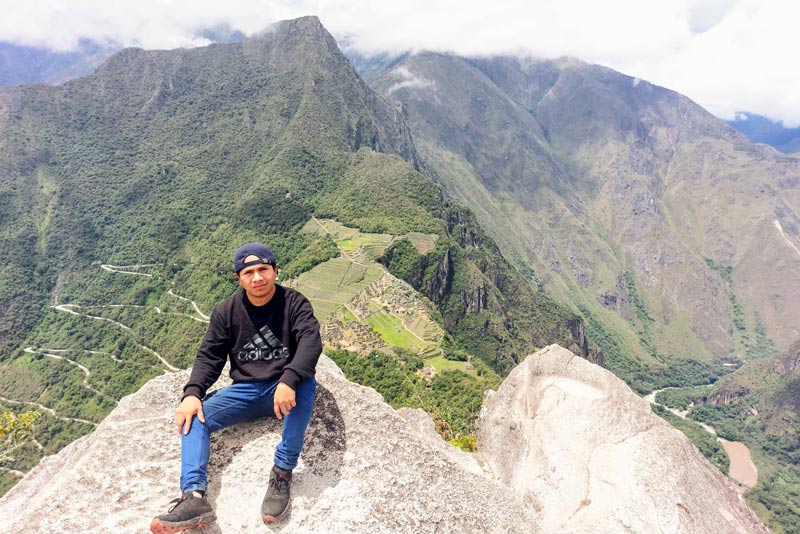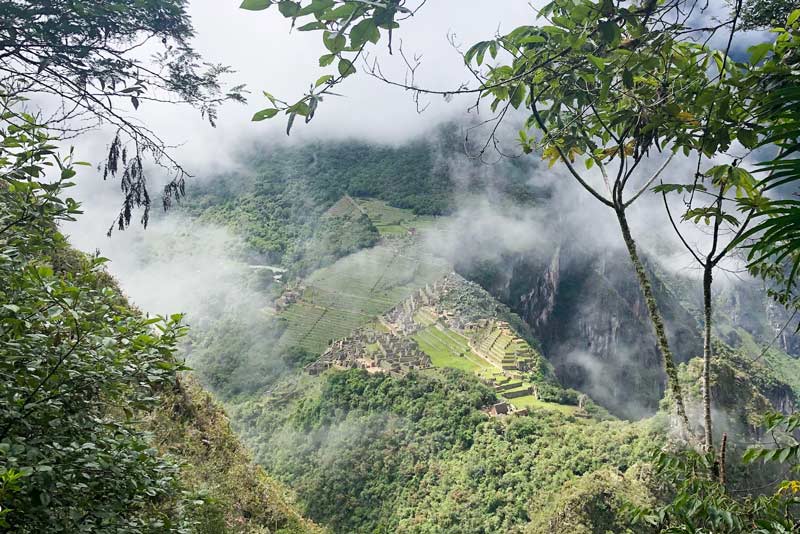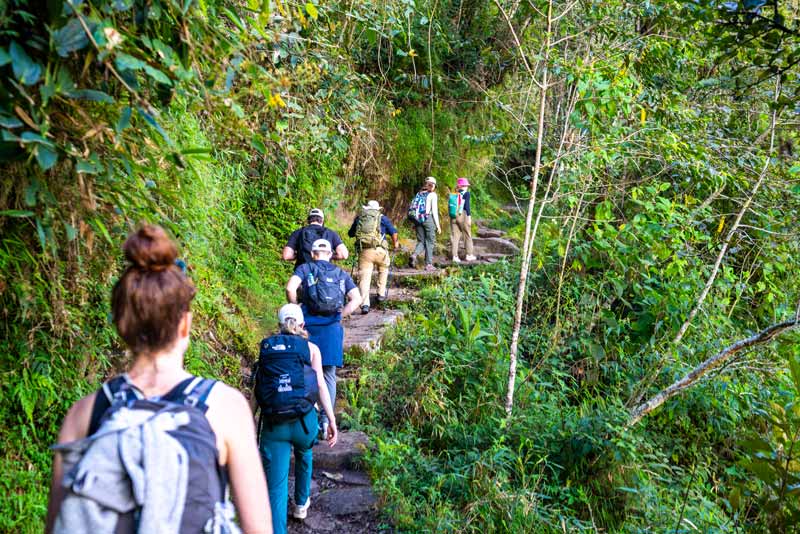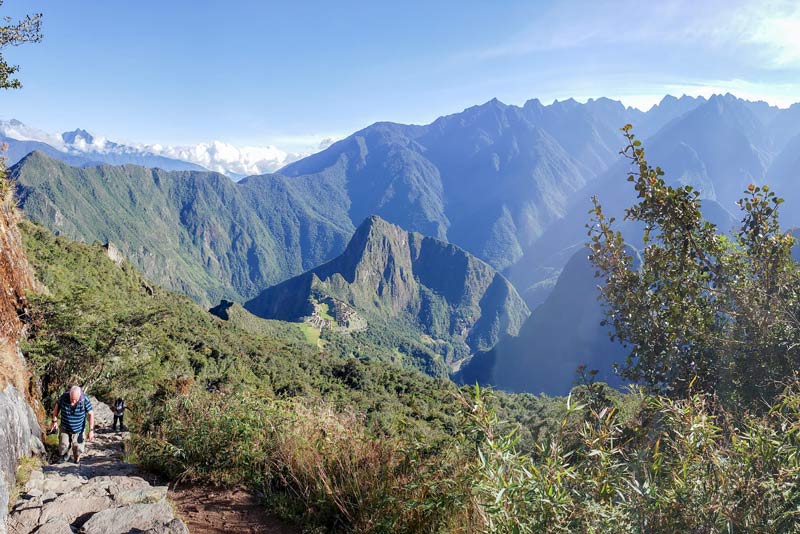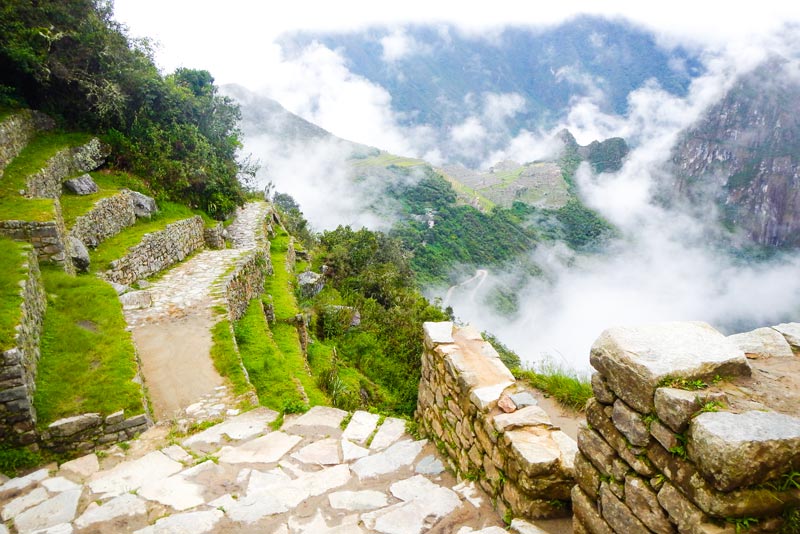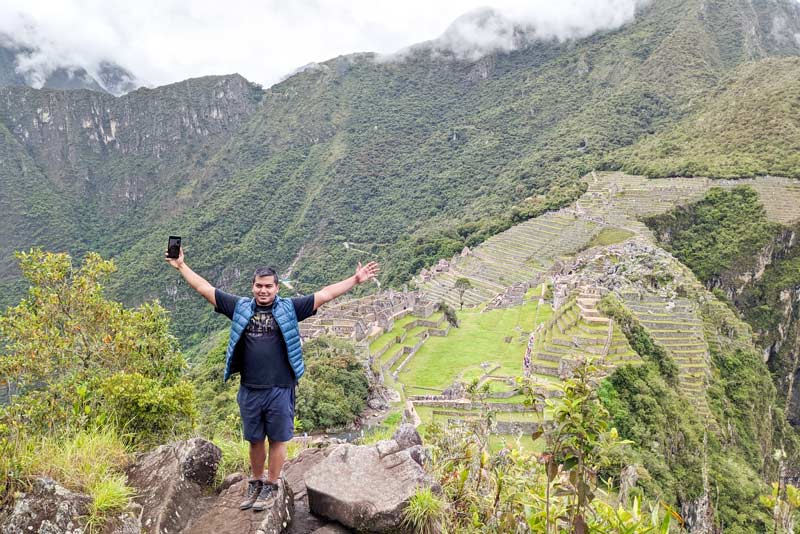Huayna Picchu: One of the most incredible short hikes in the world
Still don’t know which mountain Huayna Picchu is? Picture the classic postcard image of Machu Picchu and appreciate the highest mountain in the archaeological site. This summit is one of the most amazing places in the world, not only for its breathtaking views, but also for the adventure of reaching the top. Many people reserve tickets to this mountain months in advance, and there are only 350 tickets available for each day. Learn more about Huayna Picchu and schedule it for your next trip.
- What is Huayna Picchu and why is hiking it amazing?
- What is the hike up Huayna Picchu like?
- When is the best time to climb Huayna Picchu?
- Discover other famous hikes in Machu Picchu
- Tips for your adventure on Huayna Picchu mountain
- Frequently Asked Questions
The Machu Picchu + Huayna Picchu (Route 3A)
ticket allows entry to both the Inca citadel of Machu Picchu via Circuit 3 (Royal Route) and the mountain hike. Due to the site’s popularity, this ticket must be purchased online three months in advance. Otherwise, availability may not be available.
What is Huayna Picchu and why is hiking it amazing?
- Huayna Picchu is a Quechua word meaning “young mountain.” It’s one of the most incredible experiences you can have in Machu Picchu. It’s one of the mountains between which the Inca city is built, and where the Incas carved stone paths to its summit.
- The trails on this mountain are steep and, in some sections, close to precipices. This makes hiking them both a challenge and an adventure. Along the way, you can also see Inca structures such as terraces, enclosures, and even the famous Temple of the Moon, one of the most mysterious sites in Machu Picchu.
- From the top of Huayna Picchu, you’ll appreciate Machu Picchu in all its splendor and discover the biodiversity that surrounds it, experiencing one of the most magical moments of your trip.
What is the hike up Huayna Picchu like?
- The hike up Huayna Picchu takes approximately two hours, depending on your climbing pace (remember to take your time, enjoying every moment). The hike is estimated to cover 2 kilometers, most of which is on stone stairs. The elevation gain is approximately 300 meters from the citadel of Machu Picchu to the summit of Huayna Picchu.
- Access to this mountain is only permitted to people over 12 years old, as some sections can be somewhat dangerous. The majority of visitors who climb Huayna Picchu are young, although older adults in good physical condition are also common. The hike requires considerable physical effort, so it’s recommended to climb at a leisurely pace.
- The hike involves ascending through many stone steps on the mountainside. It can be a bit dizzying, but it’s completely safe. There are also safety ropes for support if necessary.
The entrance to the mountain
- The trail to ascend Huayna Picchu mountain begins at the Inca citadel of Machu Picchu, through the lower part on Circuit 3. It is considered by many to be one of the most amazing short hikes one can ever take.
- Its incredible, dizzying trails alongside cliffs hundreds of meters high above the Urubamba River pose a challenge that is both challenging and stimulating: they are narrow and built between the vertical walls of the mountain and the cliffs.
- These trails make many people think twice before venturing to Huayna Picchu Mountain. What they may not know is that Huayna Picchu is completely safe and that no one has suffered any serious accidents during the hike.
- However, if you’re looking for a lighter adventure, still filled with breathtaking scenery, climbing Machu Picchu Mountain may be your best option. The required ticket is Machu Picchu + Mountain (Route 1A), which has more ticket availability than Huayna Picchu.
The stairs of death
- The Stairs of Death are a section you’ll have to climb before reaching the summit of Huayna Picchu. It’s a series of stone steps near precipices, which are difficult to navigate due to their steep gradient.
- Its name, “Stairs of Death,” comes from the difficulty of climbing and descending this section. No tourist has ever lost their life climbing these stairs.
- Once you have climbed the ‘stairs of death’ you reach the top of Huayna Picchu mountain.
The top of the mountain
- The summit of Huayna Picchu mountain is located at 2,720 meters above sea level (8,923 ft).
- From there, you can enjoy some of the most impressive views of the Inca citadel of Machu Picchu. It’s an ideal place to rest and take classic photos surrounded by breathtaking landscapes.
- Reaching the mountain summit takes about two hours, with breathtaking views as each step is taken. The climb is arduous and somewhat difficult (moderate to high difficulty).
- From the top we can see the Urubamba River, the surrounding mountains and Machu Picchu along with all its buildings and temples.
The Temple of the Moon or Great Cavern
- The Temple of the Moon is a mysterious structure located on a detour on the return journey from the top of Huayna Picchu mountain.
- You will be able to see it from afar, although entry is only permitted with the Machu Picchu + Great Cave (Route 3C) ticket, which is only available during the high season (June 19 to November 2).
- This temple is one of the most incredible architectural pieces in Machu Picchu. Built inside a natural cave, it features some of the most detailed stonework in the entire sanctuary.
- The Temple of the Moon appears to be an astronomical observatory, although its purpose at Machu Picchu is unknown. Its name was given arbitrarily, as it is also known as “The Great Cavern” (a name chosen by the American explorer Hiram Bingham).
- The Temple of the Moon hike ticket is one of the best options if you can’t find an available ticket to Huayna Picchu mountain.
When is the best time to climb Huayna Picchu?
- Entrance tickets to Huayna Picchu are available year-round. Remember to purchase them online at least three months in advance. Otherwise, you may not find any available tickets.
- According to most visitors who have already hiked Huayna Picchu, the best time of year is during the dry season (May, June, July, August, September) when rain is very rare and the panorama is much clearer.
- However, the rainy season in Machu Picchu has many other advantages, such as fewer visitors to Huayna Picchu, much more colorful vegetation, and a mystical aspect that comes from being cloudy.
Discover other famous hikes in Machu Picchu
If you’re looking for more than one adventure in Machu Picchu, we’ll present the best options you can find. Each one is designed to surprise you, and they’re all day adventures, with the exception of the Inca Trail tour. (The best tickets for adventure routes in Machu Picchu)
The Inca Trail
- The Inca Trail is considered one of the best hiking trails on the planet. It’s a 4-day, 3-night (43-kilometer) trek along ancient Inca-built trails that ultimately lead to Machu Picchu.
- Nights are spent in camps, offering a highly immersive experience where we’ll also explore archaeological sites only visible on this route. To participate in this hike, you must book a tour online four or five months in advance; otherwise, there won’t be any available spots to experience it.
Machu Picchu mountain
- Machu Picchu Mountain is the other mountain that offers a hiking trail within the Inca citadel. This peak is higher than Huayna Picchu, at exactly 3,082 meters above sea level (10,111 ft), and is the reason for the archaeological site’s name. The climb to its summit is longer but less intense, ideal for people of all ages.
- The tour takes just over two hours. Most visitors who didn’t get admission to Huayna Picchu Mountain choose this mountain instead. The required ticket is Machu Picchu + Mountain (Route 1A) and must be purchased one month in advance.
The walk to Inti Punku
- Inti Punku is not a mountain, but the ancient entrance gate to Machu Picchu used by the Incas and located at the highest point of the archaeological site. Reaching the Sun Gate (Inti Punku) from the Inca citadel takes just over an hour.
- The hike is very easy, although it’s uphill, making it ideal for family outings. From the summit, you can see this little-known structure through which the sun’s rays pass during the summer solstice.
- It’s also possible to see beautiful landscapes of Machu Picchu from lesser-known angles, filled with lush vegetation. The required ticket is Machu Picchu + Inti Punku (Route 1C), which is only available during peak season (June 19 to November 2).
Huchuy Picchu mountain
- The small mountain next to Huayna Picchu is Huchuy Picchu, another impressive peak that houses Machu Picchu. The hike is easier, but you’ll also find magical landscapes and buildings that you can only discover along the way.
- The trek takes approximately two hours (round trip), traversing gently sloping paths and steps, and is a more comfortable option than Huayna Picchu. The required ticket is Machu Picchu + Huchuy Picchu (3D Route), and it is only available during peak season (June 19 to November 2).
Tips for your adventure on Huayna Picchu mountain
To ensure a more informed trip to Machu Picchu and your adventure on Huayna Picchu Mountain, we’ll share some tips and recommendations that will ensure you have the best experience on your trip. Check them out:
- The ticket required to ascend the mountain is Machu Picchu + Huayna Picchu (Route 3A), which also allows you to tour the lower part of the citadel via circuit 3, known as the Royal Route.
- Remember to book your ticket to Huayna Picchu at least two or three months in advance, regardless of the season.
- Huayna Picchu is 2,720 meters above sea level, 300 meters higher than the citadel of Machu Picchu.
- The ascent to the mountain is only available to persons over 12 years of age.
- If you decide to visit Huayna Picchu during the dry season, between April and October, you’ll find much clearer weather, with clear skies. However, it also tends to be more crowded.
- Huayna Picchu during the rainy season, from November to March, presents a greater adventure, as there’s a greater chance of precipitation during your hike. Despite this, you’ll find more peace and quiet alongside colorful landscapes.
- Acclimatizing during the first few days of your trip to Cusco is essential if you want to avoid altitude sickness.
- If you’re looking for an adventure similar to Huayna Picchu, your best option is to opt for the Machu Picchu + Mountain ticket (Route 1A).
- With Boletomachupicchu, you can book your Huayna Picchu experience. Ask our advisors about all the options available to make your trip unforgettable.
Frequently Asked Questions
1) What is Huayna Picchu mountain like?
Huayna Picchu is the mountain that appears behind Machu Picchu in the classic photo we’ve all seen. Upon reaching its summit, you’ll find Inca buildings and impressive panoramic views.
2) Is it difficult to climb Huayna Picchu?
The climb, although short, is of moderate to high difficulty, with steep trails and narrow steps alongside precipices. If you ascend calmly, it will be a challenge that can be overcome without much difficulty.
3) How long does it take to reach the top?
On average, the hike takes about 3 hours (round trip), depending on your pace. The route is approximately 2 kilometers long with a 300-meter elevation gain from the citadel of Machu Picchu.
4) What are the “stairs of death”?
They are a very steep flight of stone stairs, located near cliffs. The stairs, despite their name, are safe if you proceed with caution.
5) What ticket do I need to enter Huayna Picchu mountain?
The required ticket is “Machu Picchu + Huayna Picchu” (Route 3A). This ticket also allows you to explore the lower part of the citadel via Circuit 3.
6) What is the best time to climb Huayna Picchu?
The dry season (May to September) offers better weather with clear skies and clearer views, but there are also more tourists. During the rainy season (November to March), you’ll find fewer people and greener landscapes.
7) What can you see from the top of the mountain?
From 2,720 meters above sea level, you’ll have a unique panoramic view of Machu Picchu in all its splendor. You’ll also see the Urubamba River and many mountains with lush vegetation.
8) Do I need to acclimatize before going to Huayna Picchu?
Yes, it’s best to spend at least one or two days in Cusco or the Sacred Valley beforehand to avoid altitude sickness and enjoy the hike without any discomfort.
9) What are the best alternatives if I can’t get a ticket to Huayna Picchu?
You can choose to visit Machu Picchu mountain, Inti Punku or Huchuy Picchu. Each one offers incredible landscapes and a different experience.
10) Is it really worth going to Huayna Picchu Mountain?
Absolutely, the views, the buildings, and the satisfaction of reaching the top make it one of the most memorable moments of any trip.
Advice from people who have been there
 By: Diana M.
By: Diana M.“More than you can imagine“
“Many of the people I know have told me about this mountain, that it is quite strong and very complicated. And actually yes, it is, it is strong but not impossible. I would do it again if I came back to Aguas Calientes. It is the best mountain I have ever climbed in my life; the views you have of Machu Picchu is perfect, and a clear day allows you to see it better. If you find it too difficult, don't worry, climb at your own pace, when you get to the top you will realize that you couldn't have made a better decision. Remember that tickets must be purchased well in advance because the entrance for each shift is only 200 people, and there are only 2 shifts.“
By Ticket Machu Picchu – Last updated, August 13, 2025
